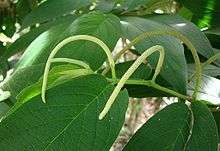Piper aduncum
Piper aduncum, the spiked pepper, matico, hierba del soldado, achotlín, cordoncillo, higuillo or higuillo de hoja menuda,[3] is a flowering plant in the family Piperaceae. Like many species in the family, the matico tree has a peppery odor. It grows wild on the coasts and in the forests of Central and South America and in the Interandean Valleys, up to 3,000 meters above sea level.
| Piper aduncum | |
|---|---|
 | |
| Scientific classification | |
| Kingdom: | Plantae |
| Clade: | Tracheophytes |
| Clade: | Angiosperms |
| Clade: | Magnoliids |
| Order: | Piperales |
| Family: | Piperaceae |
| Genus: | Piper |
| Species: | P. aduncum |
| Binomial name | |
| Piper aduncum | |
| Synonyms[1][2] | |
| |
Culinary Use
Like many species of the family, this tree has the characteristic smell of pepper. The fruits are used as a condiment and for flavoring cocoa.[4] It is sometimes used as a substitute for long pepper.
Traditional medicine
In the Amazon Rainforest, many of the native tribes use matico leaves as an antiseptic. In Peru, it was used for stopping hemorrhages and treating ulcers, and in European practice in the treatment of diseases of the genitals and urinary organs, such as those for which cubeb was often prescribed.[5]
Essential oil
The essential oil of matico contains dillapiole, ocimene and beta-caryophyllene.[6] It has high potential as larvicide against larvae of mosquitoes.[6]
Characteristics
Matico is a tropical, evergreen, shrubby tree that grows to the height of 6 to 7 meter (20 to 23 ft) with lance-shaped leaves that are 12 to 20 centimeter (5 to 8 in) long. Its fruit is a small drupe with black seeds. It is native to Southern Mexico, the Caribbean, and much of tropical South America. It is grown in tropical Asia, Polynesia, and Melanesia and can even be found in Florida, Hawaii, and Puerto Rico. In some countries matico is considered as an invasive weed.[2] In parts of New Guinea, although matico is notorious for drying out the soil in the areas where it is invasive, the wood of this plant is nonetheless used by local residents for a myriad of uses such as for fuel and fence posts.[7]
Etymology
According to legends, the plant was discovered by a wounded Spanish soldier named Matico.[2] He learned, presumably from the local tribes, that applying the leaves to his wounds stopped bleeding, and it began to be called "Matico" or "soldier's herb". It was introduced into the profession of medicine in the United States and Europe by a Liverpool physician in 1839 as a styptic and astringent for wounds.[2]
Taxonomy
Piper aduncum was described by Linnaeus and published in Species Plantarum 1: 29. 1753.[8]
- Accepted varieties
- Piper aduncum var. cordulatum (C.DC.) Yunck.
- Piper aduncum var. ossanum (C. DC.) Saralegui
- Synonyms
- Artanthe adunca (L.) Miq.
- Artanthe cearensis Miq.
- Artanthe celtidifolia (Kunth) Miq.
- Artanthe elongata (Vahl) Miq.
- Artanthe galeottii Miq.
- Artanthe galleoti Miq.
- Artanthe granulosa Miq.
- Artanthe vellozoana Miq.
- Lepianthes granulatum Raf.
- Piper acutifolium var. membranaceum C. DC.
- Piper aduncifolium Trel.
- Piper anguillaespicum Trel.
- Piper angustifolium Ruiz & Pav.
- Piper cardenasii Trel.
- Piper celtidifolium Kunth
- Piper disparispicum Trel.
- Piper elongatifolium Trel.
- Piper elongatum Vahl
- Piper fatoanum C.DC.
- Piper flavescens (C.DC.) Trel.
- Piper guanaianum C. DC.
- Piper herzogii C. DC.
- Piper intersitum f. porcecitense Trel.
- Piper kuntzei C. DC.
- Piper lineatum var. hirtipetiolatum Trel.
- Piper multinervium M.Martens & Galeotti
- Piper nonconformans Trel.
- Piper oblanceolatum var. fragilicaule Trel.
- Piper pseudovelutinum var. flavescens C.DC.
- Piper purpurascens D. Dietr.
- Piper reciprocum Trel.
- Piper submolle Trel.
- Steffensia adunca (L.) Kunth
- Steffensia angustifolia Kunth
- Steffensia celtidifolia (Kunth) Kunth
- Steffensia elongata (Vahl) Kunth[9]
References
- Barlow, Prof. Snow (2003). "Sorting Piper names". University of Melbourne. Retrieved 2007-03-29.
- Taylor, Dr. Leslie (2006). "Technical Data Report for Matico (Piper aduncum, angustifolium)" (PDF). Raintree Nutrition, Inc. Retrieved 2007-03-29.
- "Piper aduncum". Natural Resources Conservation Service PLANTS Database. USDA. Retrieved 5 October 2015.
- Seidemann, Johannes (2005). World Spice Plants: Economic Usage, Botany, Taxonomy. Springer. pp. 289. ISBN 978-3-540-22279-8.
- Remington, Joseph P. (Ed); Horatio C. Wood (1918). "The Dispensatory of the United States of America". Retrieved 2007-03-29.CS1 maint: extra text: authors list (link)
- Scalvenzi, Laura; Radice, Matteo; Toma, Luciano; Severini, Francesco; Boccolini, Daniela; Bella, Antonino; Guerrini, Alessandra; Tacchini, Massimo; Sacchetti, Gianni; Chiurato, Matteo; Romi, Roberto; Di Luca, Marco (2019). "Larvicidal activity of Ocimum campechianum, Ocotea quixos and Piper aduncum essential oils against Aedes aegypti". Parasite. 26: 23. doi:10.1051/parasite/2019024. ISSN 1776-1042. PMC 6469466. PMID 30994444.

- Siges, T.; A.E. Hartemink; P. Hebinck; B.J. Allen (2005). "The invasive shrub Piper aduncum and rural livelihoods in the Finschhafen area of Papua New Guinea" (PDF). Human Ecology. 33 (6): 875–893. doi:10.1007/s10745-005-8214-7. Retrieved 2007-04-16.
- "Tropicos | Name - !Piper aduncum L." www.tropicos.org. Retrieved 2019-06-02.
- "Piper aduncum L. — The Plant List". www.theplantlist.org. Retrieved 2019-06-02.
External links
| Wikimedia Commons has media related to Piper aduncum. |
| Wikispecies has information related to Piper aduncum |
- Piper aduncum by Alfred Hartemink
- Friday Fellow: "Spiked Pepper" at Earthling Nature.